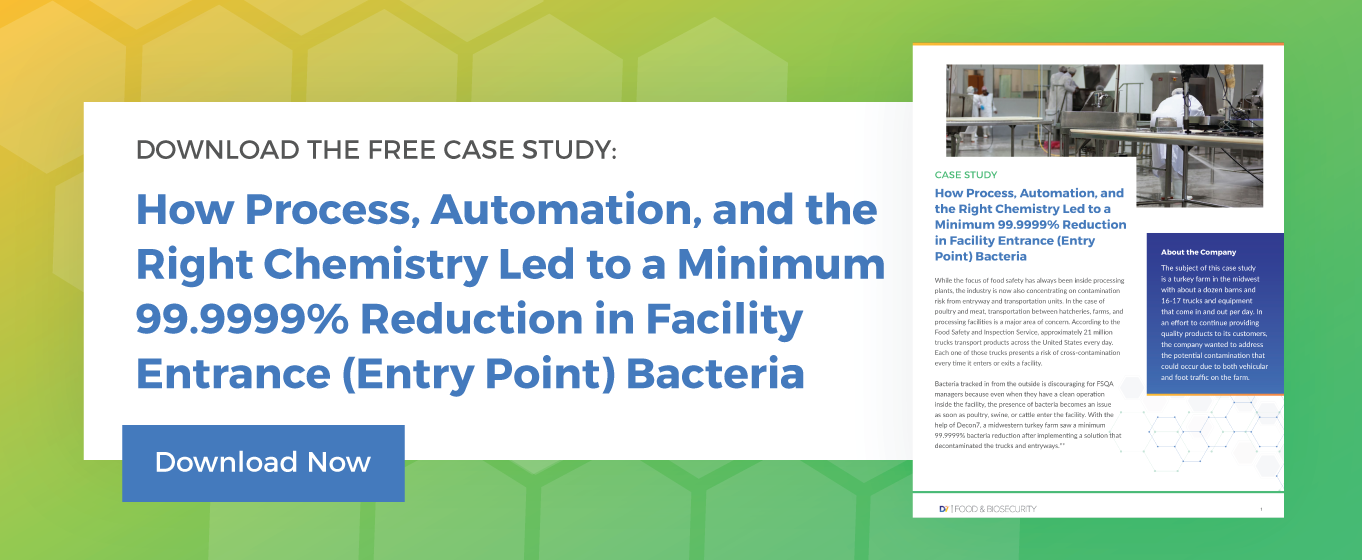
D7 was originally developed with a different end-use in mind, but its ability to safely and effectively clean, disinfect, sanitize, and deodorize has made it a popular product for food safety and biosecurity applications. Although its first use in a food processing facility is often to address an outbreak, D7 can also be incorporated into a daily sanitizing strategy to help prevent outbreaks from occurring in the first place. If you’re not sure whether a sanitizer like D7 is right for your facility, these are some of the most common use cases in food safety and biosecurity.
Food Processing Applications
D7 has been used by some of the industry’s largest producers of ready-to-eat food and facilities designed for slaughter, evisceration, and further processing. Applied during both daytime and nighttime sanitation protocols, it can be used to treat areas such as:
- Walls and ceilings
- Work surfaces
- Refrigeration units
- Entryways
- Drain covers and pans
- Harborage areas, including cracks and holes
One of the primary advantages of D7 is the ability to apply it as a stable foam that adheres to vertical surfaces and ceilings for the minimum recommended time required for the product to work. It’s easy to apply, and, unlike many other sanitizers, no mechanical action is required to remove biofilms. The solution can also be used with most equipment that is currently used in sanitation operations, making it easy and cost-effective to switch.
D7 is also great for treating the areas that are not easy to see or reach, such as drain pans and small cracks and holes where bacteria can live. These areas are particularly important to consider for food safety because biofilms can grow and thrive within them. However, when D7 is applied on a daily basis, biofilms are less likely to form because bacteria is consistently brought down to safe levels.
Live Production Applications
Biosecurity is necessary to protect people, property, and livestock from the spread of viruses, bacteria, and other microorganisms. In addition to food safety applications, D7 has been used in live production facilities as part of biosecurity protocols in hatchers and egg processing plants for cleaning, disinfection, and deodorization of areas such as:
- Barns
- Feed delivery trucks
- Feeder bowls
- Water feed lines
- Transportation terminals
- Trucks
One food safety factor that many people don’t consider in processing facilities is the connection between the farm and the processing plant. The vehicles, equipment, and personnel that interact with both areas have the potential to contaminate an otherwise clean food processing facility after visiting a farm. A specific example of D7 in action is the case study about a turkey farm that reduced facility entrance bacteria by 99.9999%. By successfully addressing bacteria on transportation equipment and entryways at the farm, the company was able to reduce the incidents of contamination at the processing plant.
Why D7 is Effective
In combination with the personal behaviors—washing hands, disinfecting footwear, etc.—that help prevent the spread of bacteria and viruses, D7 helps prevent food contamination by killing bacteria on surfaces and in biofilms. It can be applied as a foam or by atomizing, depending on the use case, making it a versatile sanitizer for any type of food safety or biosecurity application. Because D7 can be used for so many purposes, sanitation personnel no longer have to keep track of multiple chemicals. For liquid applications, specially designed mixing stations mix the components, which means that sanitation crews are not responsible for determining the right ratios.
Recurrent biofilms can be particularly challenging for sanitation crews, especially when the sanitizer that is being used requires mechanical action. Not only do they have to apply the solution to every surface, but they also have to scrub the entire surface area, which can be time consuming and labor-intensive. D7 reduces the amount of manpower required to remove biofilms because mechanical action is not necessary.
To learn more about how using D7 can be used in food safety and biosecurity, read our turkey farm case study.


